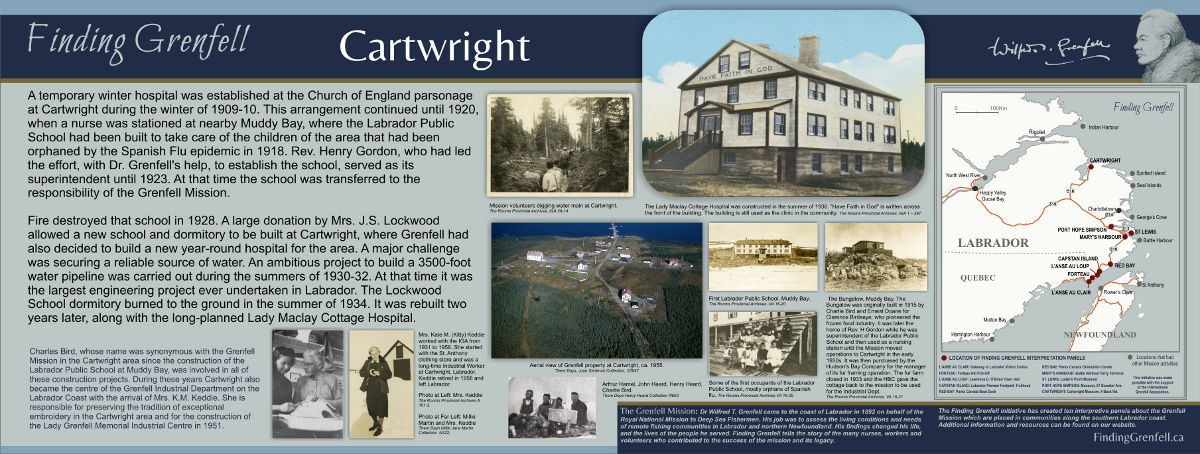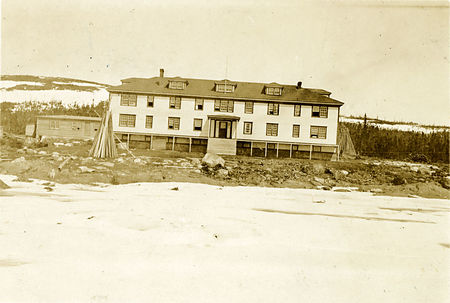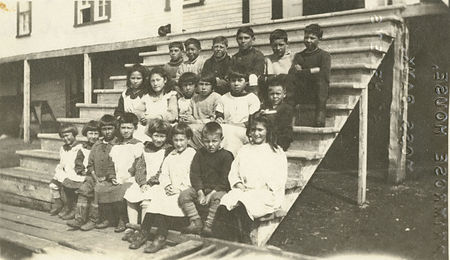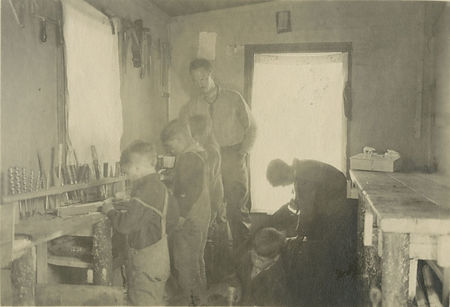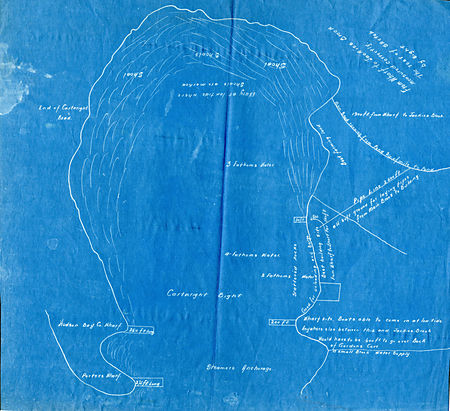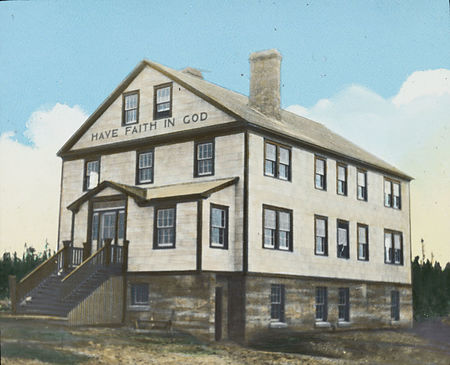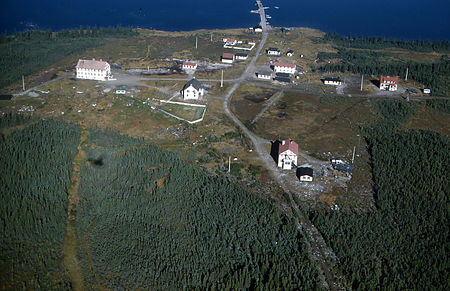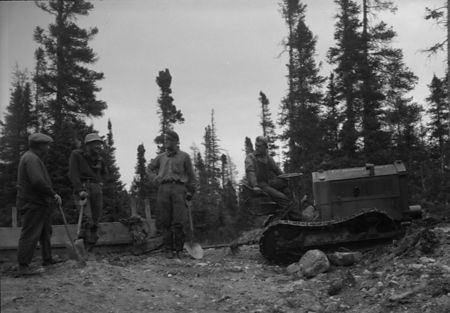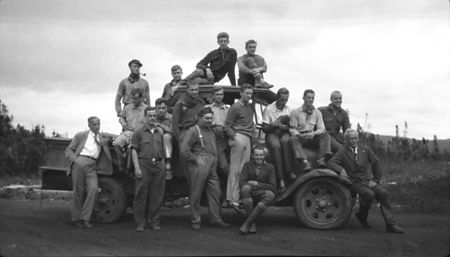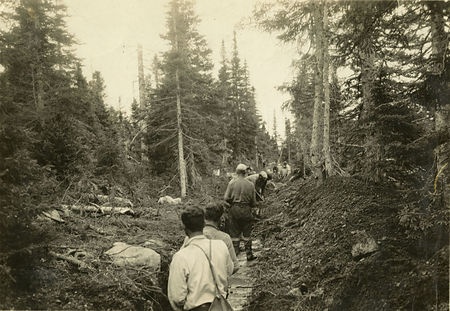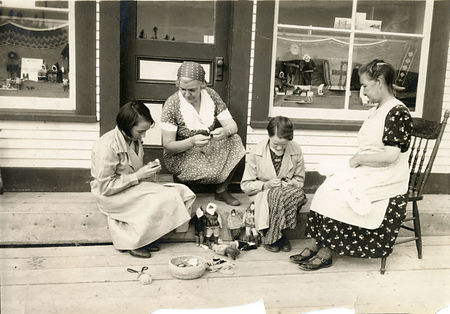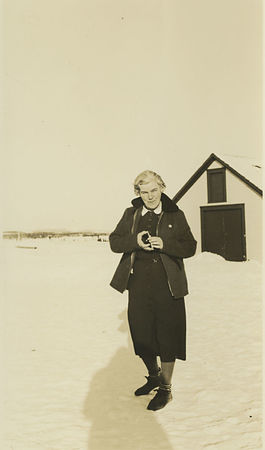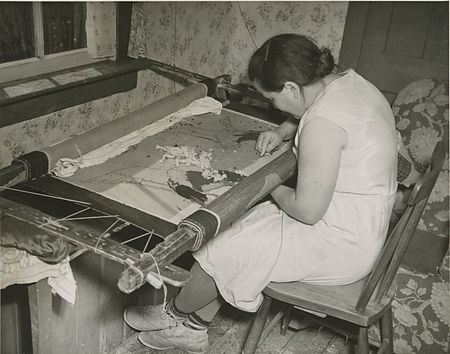Cartwright
The Grenfell presence in Cartwright started in the winter of 1909-10, when the Battle Harbour hospital was closed for the winter and Dr. Wakefield and Nurse Allan opened a small temporary hospital at the Church of England Parsonage in Cartwright. A small room was built onto one end to serve as surgery and dispensary. This continued for several winters, and by 1920 a nurse was stationed in Cartwright during the winter while the hospital at Indian Harbour was closed.
The Labrador Public School was built at nearby Muddy Bay during the summer of 1919. This was a project undertaken by the Rev Henry Gordon with Grenfell's assistance as a response to the large number of orphans left in the area by the Spanish Flu epidemic of the previous year. The building was complete enough by November to have 34 students move in.
The school at Muddy Bay was a large three storey structure with a cottage roof and five dormers. For a few years the school was run as part of the Newfoundland public school system under the direction of Rev. Gordon, but in 1923 it was officially taken over by the Grenfell Mission. At that time a new parsonage was built for Gordon at Cartwright and the bungalow used by Rev Gordon at Muddy Bay became a permanent station for nurses in the Cartwright area.
Fire destroyed the school at Muddy Bay on Feb 19, 1928. Grenfell immediately started an appeal for funds to build a new school at Cartwright. A $25,000 dollar donation from Mrs. J. S. Lockwood allowed building to start quickly and the first students moved into the school in the fall of 1930. The dormitory, known as Gordon Hall, burnt to the ground on June 19th, 1934; one student, who was isolated on the top floor with scarlet fever, died in the fire. Efforts to raise funds to rebuild the dorm started immediately. In the meantime, after the fire the school house was converted to function as a dormitory, nursing station and clothing store as well as a school.
The decision to rebuild the school at Cartwright was the beginning of major developments for the Grenfell Mission at Cartwright. A decision was made to build a year-round hospital and turn the Indian Harbour hospital into a seasonal nursing station. A sizeable donation for this project was made by Lord Maclay of Scotland in memory of his wife in 1929, but the ensuing economic difficulties of the Great Depression delayed the construction of the building.
The site for the new school and hospital selected by Grenfell was on the south side of the bay at Cartwright, on the opposite side of the harbour from the Hudson's Bay Company post. It was an ideal building site but presented a great challenge for access to water. An ambitious project to bring water a distance of more than 3500 feet from a falls on Burdett's Brook to the school and hospital site started in the summer of 1930; water ran to Lockwood School in the summer of 1932.
The waterline was dug by crews of labourers and volunteers from the United States and Great Britain. Their only equipment was a Ford truck, a temperamental tractor and an Ingersoll-Rand machine that was used as a jackhammer. It became the largest engineering feat ever undertaken in Labrador at that time.
Construction of both the Lady Maclay Cottage Hospital and the new dormitory for Lockwood School took place during the summer of 1936 under the direction of Ted McNeil, the engineer from Grenfell headquarters at St. Anthony who had also directed the construction of the waterline. Work began on both buildings in June and they were both complete and ready to be occupied by the middle of October.
Charles Bird was associated with the Grenfell Mission in the Cartwright area for many years. He and his family spent part of the year at Muddy Bay prior to the establishment of the Labrador Public School. His involvement with the Mission started with the construction of the school. He took care of maintenance of the school until it burnt. He was then involved in the construction of the new school and dormitory, the waterline and the Lady Maclay Hospital at Cartwright. It was Charles Bird who figured out a way to move the old bungalow at Muddy Bay to Cartwright in the early 1930s.
The Industrial Department at Cartwright
Cartwright became the centre of the Industrial Department on the Labrador coast. Mrs. K. M. (Kitty) Keddie came to Cartwright as director in 1934. That summer the Hudson's Bay Company, who had purchased the old bungalow at Muddy Bay, presented it to the Grenfell Mission as gift to be a home for Mrs. Keddie. The building was floated from Muddy Bay to Cartwright by a group of men organized by Charlie Bird, long-time maintenance man for the Mission at Muddy Bay and Cartwright. She named the cottage the Half-Beaver Cottage, after a fur trade token used by the Hudson's Bay Company.
Another building was later moved from Muddy Bay to Cartwright by the HBC for use as an industrial shop.
The exceptionally fine embroidery executed by women of the Cartwright area had been noticed by past industrial workers. During the 14 years that Mrs. Keddie worked at Cartwright she fostered the development and promotion of this skill with the result that Cartwright is still known for it. She was also responsible for the construction of the new and modern Lady Grenfell Memorial Industrial Building in 1951.
References
Rev. Henry Gordon, teacher Clara Ashall and nurse Ethel Graham wrote letters to the editor of Among the Deep Sea Fishers about their experiences at the newly established Labrador Boarding School at Muddy Bay, near Cartwright. The letters were published in Vol 19(1), April 1921, pp. 24-28.
http://collections.mun.ca/cdm/compoundobject/collection/hs_fisher/id/3840/rec/72
An account of Jessie Luther starting a centre for weaving near Cartwright, as well as the samples of embroidery that she collected from that area, can be found on Page 15 of Among the Deep Sea Fishers, Vol 9(3), October 1911.
http://collections.mun.ca/cdm/compoundobject/collection/hs_fisher/id/8647/rec/34
Efforts on the part of Rev. Henry Gordon and Dr. Harry Paddon to raise funds to build a boarding school at Cartwright are found in "The Labrador School and Orphanage a Fact," Among the Deep Sea Fishers, Vol 18(2), July 1920, pp. 52-53.
http://collections.mun.ca/cdm/compoundobject/collection/hs_fisher/id/3163/rec/69
In a letter to Dr. Grenfell in Oct 1920, Rev Henry Gordon outlined the progress on the construction of the school at Muddy Bay. The letter is published in Among the Deep Sea Fishers, Vol 18(4), January 1921, pp. 164-65.
http://collections.mun.ca/cdm/compoundobject/collection/hs_fisher/id/3877/rec/71
Rev. Henry Gordon married Clara Ashall, a teacher at the Muddy Bay School, on June 29, 1921. Ethel Graham, a nurse stationed at the school, describes the wedding in a letter to the editor published in Among the Deep Sea Fishers, Vol 19(2), July 1921, pp. 62-63.
http://collections.mun.ca/cdm/compoundobject/collection/hs_fisher/id/3795/rec/73
Mabel McCurdy wrote of a summer spent volunteering at the Muddy Bay School in 1921. Also in 1921, Dr. Harry Paddon submitted his first annual report as medical inspector of the school. Both can be found in Among the Deep Sea Fishers, Vol 19(3), October 1921, pp.92-95.
http://collections.mun.ca/cdm/compoundobject/collection/hs_fisher/id/3920/rec/74
On page 76 of his article "Impressions of the Mission Stations," Arthur F. Cosby describes the Industrial station at Red Bay, the purchase of the old Methodist parsonage and its expansion. The article is published in Among the Deep Sea Fishers, Vol 21(3), October 1923.
http://collections.mun.ca/cdm/compoundobject/collection/hs_fisher/id/542/rec/81
On pages 77 and 78 of his article "Impressions of the Mission Stations," Arthur F. Cosby describes the Labrador public School at Muddy Bay, including the information that the school had been officially taken over by the International Grenfell Association. The article is published in Among the Deep Sea Fishers, Vol 21(3), October 1923.
http://collections.mun.ca/cdm/compoundobject/collection/hs_fisher/id/542/rec/81
Fire destroyed the Labrador Public School at Muddy Bay, by then renamed Gordon Cove, on Feb 19, 1928. An account of the fire is found in Among the Deep Sea Fishers, Vol 26(1), April 1928, page 17.
http://collections.mun.ca/cdm/compoundobject/collection/hs_fisher/id/4630/rec/99
Efforts to restart the Gordon Cove School after the fire are described by M. Kathleen Hunt in "Our Post-Fire School at Gordon's Cove," Among the Deep Sea Fishers, Vol 26(3), October 1928, pp. 99-100.
http://collections.mun.ca/cdm/compoundobject/collection/hs_fisher/id/930/rec/101
Plans for developments at Cartwright, including building a school to replace the Gordon Gove School, building a new hospital and constructing an extensive water line, are outlined by Hanson W. Baldwin in an article called "The Cartwright Venture," Among the Deep Sea Fishers, Vol 27(3), October 1929, pp. 103-08.
http://collections.mun.ca/cdm/compoundobject/collection/hs_fisher/id/1803/rec/105
In January 1930 Dr. Grenfell wrote about the decision to make the old hospital at Indian Harbour a nursing station and centralize activities in that area at Cartwright in "Happy New Year to All," Among the Deep Sea Fishers, Vol 27(4), January 1930, page 150.
http://collections.mun.ca/cdm/compoundobject/collection/hs_fisher/id/4736/rec/106
Dr. Harry L. Paddon makes several references to the progress of work at Cartwright in "Log of the 'Maravel': Summer of 1930," Among the Deep Sea Fishers, Vol 28(4), January 1931, pp. 147-58.
http://collections.mun.ca/cdm/compoundobject/collection/hs_fisher/id/8880/rec/110
Work at Cartwright in 1930 can also be found in "Sir Wilfred Reviews 1930," Among the Deep Sea Fishers, Vol 29(1), April 1931, pp. 20-25.
http://collections.mun.ca/cdm/compoundobject/collection/hs_fisher/id/8827/rec/111
Sir Wilfred Grenfell makes several references to the work at Cartwright in the summer of 1931 in "The Log of the 'Strathcona': Summer of 1931," Among the Deep Sea Fishers, Vol 29(3), October 1931, pp. 99-113.
http://collections.mun.ca/cdm/compoundobject/collection/hs_fisher/id/11228/rec/113
Saul R. Kelson, a volunteer outdoor worker, wrote of his experiences at Cartwright in the summer of 1931. It ca be found in Among the Deep Sea Fishers, Vol 29(4), January 1932, pp. 163-66.
http://collections.mun.ca/cdm/compoundobject/collection/hs_fisher/id/8774/rec/114
Susan C. Wilson, another volunteer, spent the summer of 1931 at Cartwright. Her work included assisting with the Industrial and her experiences are recounted in "Impressions of Cartwright," Among the Deep Sea Fishers, Vol 30(1), April 1932, pp. 9-11.
http://collections.mun.ca/cdm/compoundobject/collection/hs_fisher/id/4789/rec/115
Harry L. Paddon, MD describes the undertaking to build the water pipeline at Cartwright in "The Cartwright Pipeline," Among the Deep Sea Fishers, Vol 30(2), July 1932, pp. 65-69.
http://collections.mun.ca/cdm/compoundobject/collection/hs_fisher/id/1195/rec/116
An account of the fire that destroyed the Gordon Hall dormitory in 1934 appears on pages 71 and 72 of Among the Deep Sea Fishers, Vol 32(2), July 1934.
http://collections.mun.ca/cdm/compoundobject/collection/hs_fisher/id/11485/rec/124
The story of the Half-Beaver Cottage was written by Mrs. Kate M. Keddie and appeared in Among the Deep Sea Fishers, Vol 32(4), January 1935, pp. 148-49.
http://collections.mun.ca/cdm/compoundobject/collection/hs_fisher/id/9100/rec/126
K.M. Keddie described the construction of the new dormitory and the Lady Maclay Cottage Hospital at Cartwright in 1936, with illustrations, in "The New Cartwright," Among the Deep Sea Fishers, Vol 34(4), January 1937, pp. 135-38.
http://collections.mun.ca/cdm/compoundobject/collection/hs_fisher/id/9369/rec/134
